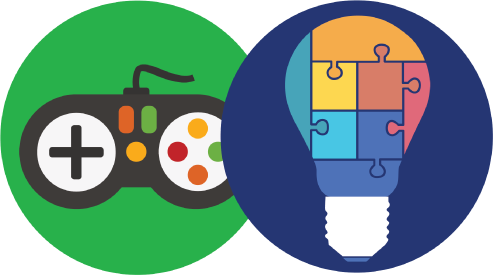Games and Learning

Figure 8 Games and Learning [edited and adapted by S. Bezzina] (Freepik #6 n.d.)
Early scholars in the field of psychology and education have studied play and its relationship with cognitive development and learning (Bruner 1983, Dewey 1910, Piaget 1962, Vygotsky 1978). Most notably, Piaget (1962) formulated a progression of developmental stages of play that correspond to consecutive stages of cognitive development in children (Piaget 1962). The early stages are characterised by paidia (Caillois 1961), in the form of practice play and make-believe activities. As children grow up, they become gradually interested in games characterised by rules or ludus (Caillois 1961). However, Piaget (1962) defined play as assimilation (Piaget 1962), where the child uses existing schema to understand new experiences and therefore no new cognitive structures are formed. Conversely, Vygotsky (1978) argued that play actually promotes cognitive development, as it ‘creates a zone of proximal development of the child’ (Vygotsky 1978, p 102), by acting as a more knowledgeable other and thus extend the potential of the child’s learning capabilities (Vygotsky 1978).
By allowing players to experience play within but on the limits of their zone of proximal development, games nurture a sense of motivation in the player by offering challenges matched to the skills of the player, in pursuit of an uncertain outcome (Malone 1980). Experimental psychologist Mihály Csikszentmihályi (1990) identifies intrinsic motivation (Malone 1980) as a prevailing factor that enhances a positive experience. According to Csikszentmihályi (1990), intrinsic motivation and deep engagement are a direct result of flow (Csikszentmihályi 1990) or the mental state in which an individual is immersed when fully involved and completely absorbed in an activity to an extent that ‘nothing else seems to matter’ (Csikszentmihályi 1990, p 4). However, in describing the 8 conditions of the theory of flow, Csikszentmihályi (1990) fails to distinguish between the precursors to and the outcomes of flow. In fact, Csikszentmihályi starts from and describes the performance of a task which offers understandable goals and instantaneous feedback as an essential precursor to experiencing flow (Csikszentmihályi 1990). The performer must then be able to concentrate on the task whilst feeling a sense of control over one’s actions. In line with Vygotsky’s notion of zone of proximal development (Vygotsky 1978), this is achieved through a balance between the personal skills possessed and the level of challenge experienced (Csikszentmihályi 1990). As a result of flow, the performer loses concern for the self and experiences an altered sense of time (Csikszentmihályi 1990). However, the ambiguity and subjectivity surrounding the construct of flow have lead to limited empirical evidence correlating flow to learning. Nonetheless, initial research (Choi et al 2007, Pearce et al 2005) suggests that flow has a positive and significant impact on learning.
Throughout the years, a rapid advancement in digital technologies, specifically the evolution in digital processing techniques, platforms and consoles, has led the characterising game elements to grow as a more predominant and vigorous force (Salen and Zimmerman 2004). Notably, games have seen robust improvements in the feedback interface, the instantaneous inter-game communication channels, the multimodal approach to interactivity and the fantasy and immersive storylines surrounding gameplay (Salen and Zimmerman 2004). This has fuelled the growing interest of educators in using games for educational purposes (de Freitas and Griffith 2007, Miller and Robertson 2010, Panoutsopoulos and Sampson 2012, Squire 2003), in order to harness and transfer the potential of games to the classroom setting (Norman 1993).
As such, apart from providing a context for repetition and recall, games can be particularly useful in fostering more complex competencies (Gee 2007, Malone and Lepper 1987, Rieber 1996), by developing and applying ‘high-level transferable skills – such as analysis, critical evaluation, autonomy, and team working’ (Whitton 2009, p 45). This is essentially achieved through the ability of games to resemble active and constructivist learning environments (Klopfer et al 2009), which amongst others allow players to discover authentic contexts through situated cognition (Squire 2005), practice problem-solving skills (Kiili 2005) and collaborate in shared endeavours (Whitton 2009). The feedback resulting from the interaction occurring during gameplay (Salen and Zimmerman 2004) supports and facilitates an experiential learning cycle (Kolb 1984), in which players experience, observe, reflect, conceptualise and finally test concepts in new situations (de Freitas 2006). A meta-analysis conducted by Vogel and colleagues (2006), reveals that computer games and other game-like activities involving simulations, contribute to higher cognitive gains and better attitudes towards learning than traditional instructional methods (Vogel et al 2006). In this sense, educational, serious, commercial off-the-shelf (COTS), browser, mobile, massive multi-player games and other game-like activities (Whitton 2009) like virtual worlds and simulations are considered to possess a definite educational value. This is due to their close approximation to optimal learning contexts (Gee 2005), where learning ‘matches up very well with emerging cognitive science research on how people think and learn’ (Squire 2005, p 7).
The interest of educators in games has resulted in the deployment of games themselves in education (de Freitas 2006, Squire 2003, Steinkuehler 2004), where the game is put at the centre of the educational process. This use of games in teaching and learning defined as game-based learning (Tang et al 2009), has seen games acting as hosts ‘into which curricular content can be embedded’ (Begg et al 2005, p 1). Nevertheless, such a game-based approach could prove itself to be problematic. First and foremost, relying solely on games for learning purposes, necessitates of complementary teaching and learning strategies (Whitton 2009, de Freitas 2006, Squire and Jenkins 2003), since ‘transfer [of knowledge] from the games to other domains…is far from automatic’ (Greenfield 1984, p 103). In fact, Ó Súilleabháin (2008) argues that transferable learning requires time and is based on a significant reflective and conscious practice (Ó Súilleabháin 2008), which helps students to ‘mobilize information [in order] to solve game-related problems’ (Squire and Jenkins 2003, p 14). Secondly, an explicit game-based approach introduces the game as an extrinsic motivator which aims at engaging and triggering interest in the student (Kirriemuir 2002, Oblinger 2004), suggesting that ‘by introducing a game element, one can make learning fun’ (Begg et al 2005, p 1), which is otherwise not.
Although admittedly supporting the use of actual games in education, in his seminal work What video games have to teach us about learning and literacy, prominent scholar James Paul Gee (2007) looks beyond the use of games as hosts for educational content (Ke 2008, Vogel et al 2006). In good games which are ‘designed to enhance getting themselves learned’ (Gee 2007, p 4), Gee (2007) recognises an inbuilt ‘theory of human learning’ (Gee 2007, p 4), based on principles of learning which gamers master through gameplay. Furthermore, Gee (2005) suggests that the application of these principles to educational contexts, has the ability to possibly transform learning, without relying on the game per se. Begg and colleagues (2005) build on Gee’s (2005) work by arguing that the learning experience is in fact enhanced, as it becomes ‘informed rather than supplemented by processes identified with successful gameplay’ (Begg et al 2005, p 1). As such, for the purpose of this dissertation and in response to the problems which might arise in a game-based approach, the term game-informed is defined as the use of gameplay elements and principles of learning found in good game designs to strengthen learning and assessment practices. This definition, based on my own distinction between game-based and game-informed approaches, centres on the conceptual use of gameplay elements and principles of learning found within, rather than the deployment of actual games in education. It also seeks to extend the nature of a game-informed approach, particularly towards assessment.
Click below to continue your journey through literature:
Figure 7 Continue your journey through the Review of Literature [edited and adapted by S. Bezzina] (Freepik #4 n.d.)



